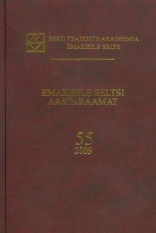EESTI MURDESÕNA VING
THE ESTONIAN DIALECT WORD VING
Author(s): Vilja OjaSubject(s): Language studies, Phonetics / Phonology, Lexis, Finno-Ugrian studies
Published by: Teaduste Akadeemia Kirjastus
Keywords: etymology; loan words; sound change; Estonian dialects; German language;
Summary/Abstract: While slaughtering pigs, in olden times Estonians have closed the animal’s mouth using a string noose, put around the pig’s snout and tightened with a wooden toggle. This prevented the pig from shrieking or biting. This tool has been named in the vernacular mostly according to one of the two parts (either the noose or the toggle), e.g. seaninapöör ‘pig snout toggle’ nõnapulk ‘snout stick’, seaprill, -prillid ‘pig eyeglass(es)’, ninaprill ‘snout eyeglasses’, vahr ‘hoop’, and others. In south-eastern Estonia, as well as occasionally in the Islands dialect, this object is called ving, vinguss or similar, and a verb formed from the same stem has been used as well. The use of a word with the stem ving in this sort of meaning cannot be justified on the basis of the Estonian word stock and its origin is unknown. In this article, two possible loan etymologies for the Estonian ving stem are presented. First, the loan source may be the German noun Zwinge, which has emerged as ving in Estonian through the regular sound change zw- > v-. Alternatively, the source word may be the Low German verb winden or the noun winde (cf. German Windung), with the sound change d > g, found in other Estonian words as well.
Journal: Emakeele Seltsi aastaraamat
- Issue Year: 2017
- Issue No: 63
- Page Range: 116-126
- Page Count: 11
- Language: Estonian

